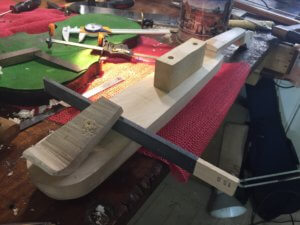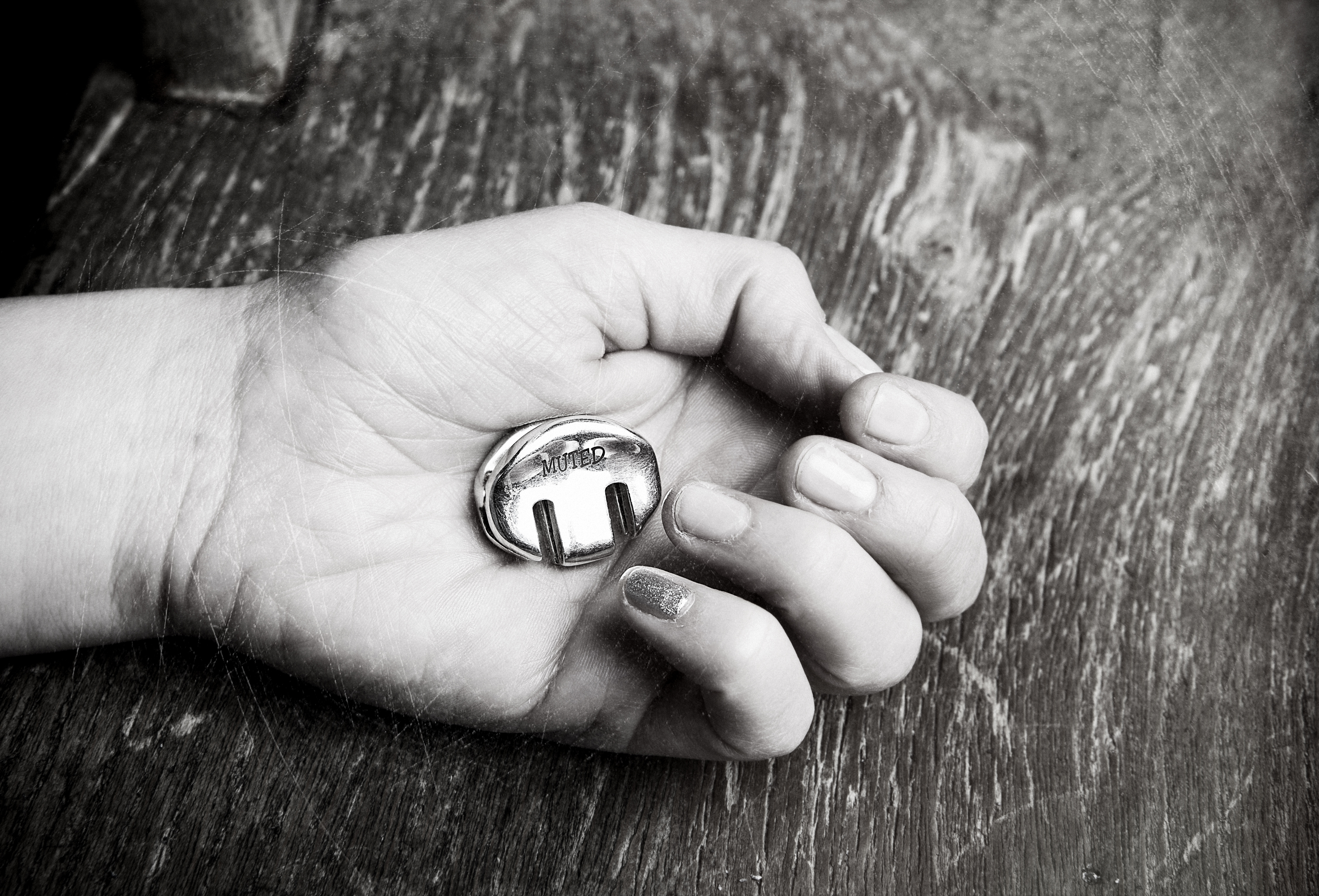Decibels & Instruments & Mutes: the backstory
What’s in a decibel?
The specialists were unanimous: my ears are highly sensitive to sound. ‘Geluidsgevoelig,’ in Dutch. It sounded almost positive to me, ‘sensitive to sound.’ It’s also
not uncommon. But a high sensitivity to sound means that my ears are more prone to damage. A person standing next to me could be exposed to exactly the same sounds, yet not be affected. The advice was clear: I needed to protect my hearing by significantly reducing my exposure to high decibel (dB) levels.
Decibel levels and the key concept of duration: what is considered safe? How many dB for how long? Impossible questions to answer infallibly, but working with the Audiologisch Centrum Hilversum brought clarity to a complex situation. They measured the decibel levels of
different violin mutes (a.k.a.
sourdine, sordino, demper), giving estimates and advice about a multitude of issues. Many thanks to experts N.J. Versfeld and J.P. Kronemeijer, and Oorwerk’s Stijn Hoogeboom in Hilversum.
A runner hears: if they keep running at high speeds, chances are high that in future years they’re going to have serious knee pain. They might even need surgery. But if they slow down to a fast walk, chances are they could avoid that. So the runner chooses to protect their knees by going from running to a fast walk. In hearing terms, my ‘fast walk’ is about 80 decibels. My acoustic violin can measure 90-95 dB under my ear.
Confronted with the fact that it would be reckless to continue exposing my ears to a high level of decibels, I had to make choices. I was lucky that I learned this sooner rather than later. I consoled myself with that knowledge while evaluating the decibel levels of treasured and prospective collaborations. I said farewell to click tracks, bass drums, and high-volume soundtracks. I sifted through pieces that were simply too loud for me now, many of them close to my heart, and started the process of finding them new homes, new interpreters.
There’s a passage from Igor Stravinsky’s Poetics of Music: ‘My freedom will be so much the greater and more meaningful the more narrowly I limit my field of action and the more I surround myself with obstacles. Whatever diminishes constraint diminishes strength. The more constraints one imposes, the more one frees one's self of the chains that shackle the spirit.’
Limits inspire creativity. MUTED opens doors for a new voice. There's power in quietness and strength in speaking softly.


pictured here: the frame violin, also known as a mute violin, ca. 1870. It has a beautiful, intimate, overtone-rich sound. Surprisingly little is known about these striking instruments. One resource is the National Music Museum at the University of South Dakota, whose collection houses what could be this frame violin's sister...
MUTED
Cue the new music community: resourceful, supportive and stubborn composers and colleagues who lifted me up and pulled me along this fascinating journey. Ups and downs and the unexpected began to feel like the status quo. Michael Gordon's response to what was drastic news to me —having to protect my hearing by stopping or adapting how I played the violin — was one of optimism and curiosity. I'll never forget his words: “I’m going to write you a piece so soft, I don’t care if no one can hear it.” Michael, David Lang, and Julia Wolfe decided to join forces to create MUTED, “the quietest violin piece ever written.” The three later invited Louis Andriessen to join in the experiment, fulfilling a long-held wish to collaborate.
Watch musical excerpt by Louis Andriessen here (Podium Witteman, live television broadcast)

There is an enormously talented and resourceful pool of people involved, including stage and light designer
Floriaan Ganzevoort, executive producer Neil Wallace & De Doelen, numerous mute creators, filmmakers, audiologists, producers, commissioners, as well as a swath of venues and festivals. The list* is long and heartwarming.
Special thanks to luthier
Bas Maas and designer
Marcel Wanders, who created an entirely new, lower-decibel instrument, a ‘
whisperviolin,’ inspired by and loosely modeled on the 17th-century ‘pochette’ violin, but made to explore the world of quieter sounds. Besides unmatched creativity and unparalleled skill, both bring a sense of adventure and a palpable excitement to the process.
MUTED has its roots in the reaction from composers to my high sensitivity to sound and having to cut down the amount of decibels pouring into my ears. I used to play pretty hard-hitting music, much of it newly commissioned. I took measures to protect my hearing and left the world of orchestral playing many years ago, but I was probably
one of the loudest violinists around. And as Mehitabel** would say, “I have no regrets!” But saying farewell to a repertoire close to my heart has its difficult moments, and tough choices abound.
It’s new territory for me, there’s an uncharted development process ahead, and a completely new sound world to figure out. My work has always been composer driven, and I am extremely grateful to and moved by the active role composers and colleagues are taking in this enforced, bewildering, and somehow increasingly exciting development in my creative path as a musician.
**MUTED includes a part for my (speaking & singing) voice, in settings of texts from Don Marquis’ 1930’s New York Post cult column 'Archy and Mehitabel.'
The mutes in MUTED
Central to Monica Germino’s work is her unusual family of instruments, as well as her ever-expanding collection of mutes. Germino’s ongoing search has resulted in over 400 vintage, modern, and newly commissioned mutes. A mute (a.k.a. sourdine, sordino, demper) can alter the sound of the violin in countless ways. From Canada to Spain, mute-makers are experimenting with new designs and all kinds of materials – leather, metal, cork, magnets, plexiglass, bone, rubber, paper, textiles, the list goes on. Special thanks to Stam Vioolbouw for their marvelous donation to the collection.


The instruments
- A (muted) J. B. Ceruti violin from Cremona (1802) on permanent loan from the Elise Mathilde Foundation
- A rare frame violin, also known as a mute violin, with a delicate, surprisingly overtone-rich sound (ca. 1870)
- A custom-made Violectra electric violin (2007)
- The ingenious whisperviolin (2019), by Bas Maas and Marcel Wanders
- A ‘whisperbow,’ made of carbon fibre, produces a wispy, delicate sound
The whisperviolin (2019)
To add to the instrumentarium, luthier Bas Maas and designer Marcel Wanders created an entirely new, lower-decibel instrument, a ‘whisperviolin,’ inspired by and loosely modeled on the 17th-century ‘pochette’ violin, but created to explore the world of quieter sounds. When Wanders took on this challenge, he spoke about decibels and sound and his fascination with “designing a violin for Monica, and how this could ultimately also help other violinists.” Marcel Wanders played the violin for 6 years and reveres its history, shape, and form. Bas Maas is on a quest for ways that unconventional ideas could possibly work. Besides unmatched creativity and unparalleled skill, both bring a sense of adventure and a palpable excitement to the process.
Marcel Wanders: “The hope also is that this new instrument will end up helping other violinists as well. Monica is not the only one going through this.”
I wholeheartedly agree. As interesting as this whole journey is, I hope going down this path can help other musicians. On that note...
Frequently Asked Questions:
"Why don’t you just use earplugs?” For those who do and can still enjoy music-making, that's great. I tried this option for many months, but it felt like sensory deprivation. I rely on (and love) the subtle sounds associated with playing the violin. It's essential for me to hear the tapping of my left hand on the fingerboard and the sound the hair of the bow makes when touching the string. Earplugs block those sounds out. This all contributed to my decision to bring down the volume of the violin instead of muffling my ears. That said, of course I fully support the use of hearing protectors.
"Do your ears hurt?" No. That said, certain loud or abrasive sounds hurt. Which brings me to...
"What is hyperacusis?" This is something I suffer from, albeit to a lesser degree than described in the majority of the cases I have read about online. I notice hyperacusis during activities like emptying a dishwasher- the sound of a plate striking another plate is an unpleasant, jarring sound for me. I hesitate to provide a comprehensive link to any one source, as there is a lot of information out there.
Other useful articles (please
email me if you have tips or suggestions)
WNPR News: How Your Hearing Is Affected By Volume, and What the Damage Sounds Like
There is a flood of information, research, and articles about hearing protection and hearing disorders available online and in print. I have found that the majority focuses on musicians who play amplified, and orchestral musicians (too many cases for me to document here).
If you're still with me:
June 2018 marked the world première at the Netherlands’
Oranjewoud Festival, as part of Leeuwarden’s 2018 Cultural Capital of Europe programme.
A collective work by 4 composers for violin, voice, whisperviolin, frame violin, a multitude of mutes, and light design
Composers: Louis Andriessen, Michael Gordon, David Lang, Julia Wolfe
Notes about the program:
The collective composition MUTED features violin, voice, whisperviolin, frame violins, hundreds of mutes, and light design. Created in response to Germino's high sensitivity to sound, Michael Gordon, David Lang, and Julia Wolfe joined forces to create a piece that explores the limits of audibility. The three composers invited Louis Andriessen to join them in the experiment, fulfilling a long-held wish to collaborate. Floriaan Ganzevoort designed a light object based on sound waves, controlled live in performance.
While the label “quietest piece ever written for violin” certainly applies to parts of this 4-composer work, the contrast in audibility plays an essential role. Similar to how pupils expand and contract depending on how much light there is in a space, the different decibel levels play with sonic perception. A frame violin (ca. 1870) with a delicate, surprisingly overtone-rich sound is featured alongside the ingenious 'whisperviolin' (2019), created by designer Marcel Wanders and luthier Bas Maas. Other instruments are paired with metal-tipped fingers or bespoke mutes from an ever-expanding collection of more than 400 vintage, modern, and newly commissioned mutes. Monica’s singing voice is heard in settings of texts from 'Archy and Mehitabel,' a compilation of Don Marquis’s writings in his daily column, where they first appeared in 1916.
This intensely theatrical piece is conceived for small groups of listeners in intimate spaces. MUTED may owe its origins to four composers paying tribute to the determination of a single musician, but it is also a reflection on silence, on the act of listening, an antidote to the noise and the ever-increasing clamor of today’s world.
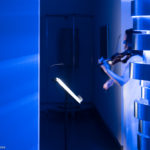

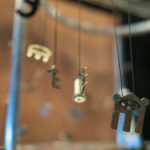

Light design by Floriaan Ganzevoort
*Cast of credits, MUTED:
Commissioners
The Doelen, Rotterdam (Neil Wallace, Executive Producer)
Oranjewoud Festival, Oranjewoud
New York Philharmonic Orchestra, New York
Music on Main, Vancouver
Huddersfield Contemporary Music Festival
Partners and presenters
Wonderfeel Festival
Korzo Theater, Den Haag
Muziekgebouw aan ‘t IJ, Amsterdam
November Music, Den Bosch
With thanks to
Michael Gordon, Julia Wolfe, David Lang, Louis Andriessen
MassMoCA, Massachusetts, USA
Kenny Savelson, Bang on a Can All-Stars
Phillipa Thompson, Bang on a Can Summer Festival
Vera Kuiper, Dutch Consulate, New York
Neil Wallace, Programme Director, de Doelen
Bas Maas, luthier
Marcel Wanders, designer
Niek Versfeld and Jaap Peter Kronemeijer, Audiologisch Centrum Hilversum
Stijn Hoogeboom,
Oorwerk, Hilversum
Bas Andriessen, filmmaker
Jacqueline & Serge Stam, Stam Vioolbouw
Fonds Podiumkunsten / Performing Arts Fund NL
MUTED in the press
New York Times reviews MUTED
The Wall Street Journal Philharmonic Dials Down Music to a ‘Whisper’
New York Times: MUTED on the top of the list
6 Classical Music Concerts to See in N.Y.C. This Weekend
The Georgia Straight, Vancouver CA: Diagnosis sends violin star Monica Germino in search of softer sounds at PuSh fest
De Volkskrant: Violiste Monica Germino kan door speciaal voor haar geschreven zachte stukkenweer spelen
NRC Handelsblad: 10 jarige Red Sofa opent met Monica Germino’s zachtaardige viool
The Washington Times
Oberon’s Grove
Broadwayworld.com announcements & here
New York Philharmonic press release
VIDEO
Music on Main about MUTED
Podium Witteman, live: fragment van MUTED
Full broadcast: Podium Witteman
The New York Times -Anthony Tommasini

The violinist Monica Germino in "Muted," presented by the Philharmonic at National Sawdust in Brooklyn.
"... the impressive and courageous violinist Monica Germino gave the American premiere of “Muted,” a 40-minute, musical-theatrical work written for her by four composers: Michael Gordon, David Lang, Julia Wolfe and Louis Andriessen.
Ms. Germino was a champion of contemporary music, including experimental works with percussion and electronics, when, a few years ago, she was diagnosed with a hearing condition that rendered her extremely sensitive to sound. She must avoid exposure to high volume of any kind.
“Muted” was the response of four composer colleagues. The piece involves very soft sounds played on an array of violins, from traditional to experimental, and used various standard mutes (brass pieces fitted on the bridge of the instrument to muffle sound). During parts of ”Muted,” Ms. Germino also sang or spoke fanciful texts by Don Marquis and moved around a central, light-projecting circular tower of aluminum rings (designed by Floriaan Ganzevoort).
While wistful, the music shifts through moods and styles that alternately suggest tender folk songs, gently swaying dances, bursts of hushed busyness, bluesy melodies, even twangy hints of hoedown. “Muted” may be the quietest piece ever written for violin, but it was riveting in this intimately powerful performance."
read more
The Wall Street Journal - A violinist with a sensitivity to sound will perform ‘Muted,’ a special, quieter piece for audiences in Brooklyn
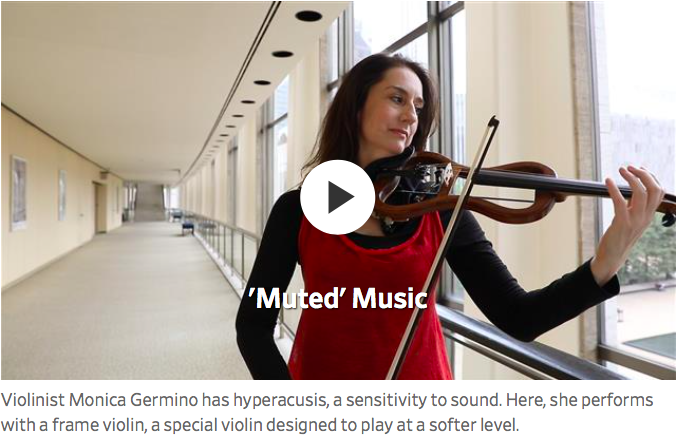
Violinist Monica Germino performs on a frame violin, which is quieter than a traditional violin, at New York’s Lincoln Center. A caveat: the audio in the video segment is louder than in performance
"The composers involved explain that “Muted” isn’t necessarily difficult for audiences to hear. [Michael] Gordon said concertgoers just need to pay closer attention. He likens it to stepping into a dimly lit room and adjusting your eyes until you can see clearly once again..." The Wall Street Journal
Live TV broadcast Podium Witteman -the MUTED segment starts at 6'55" (in Dutch). Music: 19'30"

Excerpt by Louis Andriessen here
Violinist Monica Germino can play again, despite hearing problems, thanks to quiet pieces written especially for her
NRC Handelsblad (NL)
Excerpts translated from Dutch
Red Sofa celebrates 10 years, opens festival with Monica Germino’s quiet violin
Adventurous violinist Monica Germino enthusiastic about Red Sofa's new music program in Rotterdam's De Doelen
"...As the pop-up artist, Monica Germino will decide what she will actually play in the moment. It will certainly be soft, because a few years ago Germino was diagnosed as 'sensitive to sound,' which means that her ears are more prone to damage [from high decibel levels]. She had to say goodbye to the high-octane soundtracks and louder works for electric violin, giving up many pieces she had often performed.
She is now "more curious than sad," says Germino. Playing quietly opens up a whole new dimension; and apart from a reflection on silence and listening it can also be "an antidote to the relentless noise of our world." She has amassed a huge collection of mutes (sourdines) and plays a rare 'frame violin' from ca. 1870, an instrument without a sound box which therefore plays at a very low volume. Germino: "Neil [Wallace] wants me to play the frame violin in the Main Hall without any amplification; for me that's a thrill, an adventure." Wallace: "You will hear a pin drop.”

Spring Loaded Festival: 10 years of Red Sofa. De Doelen Rotterdam.
photos: Anne Reinke










